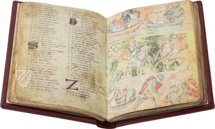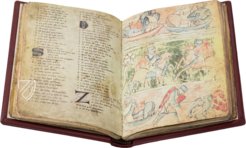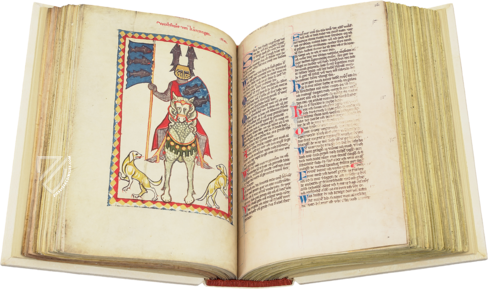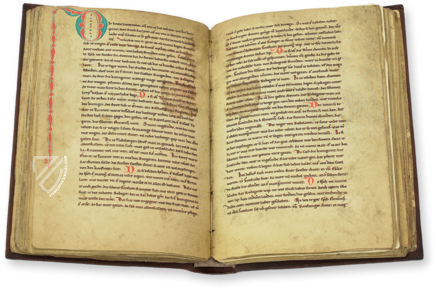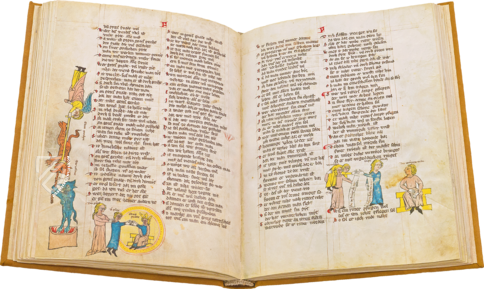Gottfried von Strassburg: Tristan and Isolde
(1,000€ - 3,000€)
Elegant ladies in genteel dresses, crowned heads at a feast and agile horses at a tournament. Such courtly portrayals and others like them are found in the artistic illustrations of Gottfried von Strassburg’s Tristan-fragment from the Bavarian State Library in Munich. The oldest surviving manuscript – originating from around 1240/50 – of this “most lithe and melodious of all German poetry from the Middle Ages” amazes not only through the entertaining text, but also through the numerous detailed illustrations.
Gottfried von Strassburg: Tristan and Isolde
The main work of the most important medieval poet originated, as the name affix of the author indicates, from the Alsace region. Influenced by German and French court poetry, Gottfried von Strassburg revised the widespread Tristan material according to Anglo-Normanic source material. Yet the Tristan poem remained only a fragment, and was resumed and completed by Ulrich von Türheim. To this day, Gottfried von Strassburg’s Tristan and Isolde is considered to be “the most artistically advanced German tale from ca. 1200”. That the poetry was already counted among the most beloved works of literature in Gottfried’s lifetime and across the following centuries is also proven by the fact that the Munich manuscript boasts stark signs of use and stress. The oldest surviving copy of a Tristan manuscript according to Gottfried’s poetry was probably produced in the middle of the 13th century in either the region of Swabia or Lake Constance. On 30 full-page miniatures in addition to the text, the Tristan material is told with fine painting in thrilling pictures. The masterpiece of court poetry, which still leads the canon of Old German literature today along with the Song of the Nibelungs or the Arthurian legends, was organized into two columns respectively and recorded with perfectly legible, fine script with a few initials. A story about the central motif of courtly love was spun in an exciting fashion.
The Courtly World in Powerful and Delicate Colors
The 30 illustrated pages are divided into three strips, respectively. Each of these picture fields shows a primary scene from the geste about the protagonist Tristan. The background of the scenes are mostly monochrome in a luminous color such as intense red, yellow, or blue, as allowed to emerge by the scenes in the foreground. The scenes mentioned are acted out against this powerfully colored background. The figures are either depicted predominantly in monochrome and skillfully drawn with a quill or are additionally colored in what originally were probably luminous, bright colors, which are faded today because of its frequent use. The diverse gestures of the delicate figures are particularly delightful, lending the scenes exciting movement and tension. The manifold, sometimes very expressive faces of the figures exactly express what the depictions and text want to convey. The tale of Tristan and Isolde, like in the text, was imbedded into the contemporary court living environment. Today, Gottfried’s text and illustrated pictures offer us with an entertaining, informative, and intense glimpse in the Middle Ages, its lifestyles, and ways of thinking.
Codicology
- Alternative Titles
- Gottfried von Straßburg: Tristan und Isolde
- Size / Format
- 218 pages / 24.0 × 16.0 cm
- Origin
- France
- Date
- Second quarter of the 13th century
- Epochs
- Style
- Genre
- Language
- Script
- Gothic cursive
- Illustrations
- 30 pages with numberous individual scenes arranged in tapestry-like picture strips
- Content
- The romance of Tristan and Isolde
- Artist / School
- Gottfried von Straßburg (d. ca. 1215) (author)
Ulrich von Türheim (ca. 1195 – ca. 1250) (author)
Gottfried von Strassburg: Tristan and Isolde
Cassie Hands Kahedin the Key to the Castle
In Arthurian legend, Sir Kahedin is the son of King Hoel of Brittany and a close friend of Tristan’s. Kahedin is in love with Cassie, the wife of Nampotanis, who is kept locked up in his castle. The lovers conspire to meet by having Cassie make a wax impression of the key, which she then gives it to Kahedin. They are able to fulfill their desires and spend blissful moments in each other’s arms, but never meet again because Kahedin is killed by Nampotanis after his wife’s betrayal is revealed.

Gottfried von Strassburg: Tristan and Isolde
Tristan’s Return to Ireland
Shortly after returning to Ireland on behalf of King Marke of Cornwall, Tristan slays a dragon but is wounded himself and falls in a river. In the top register of this page, Isolde, Brangaene, and her mother the Queen ride out to find the dead dragon. The next scene shows them pulling an unconscious Tristan, wearing a “great helm”, out of the river and taking him back to their castle.
As Tristan bathes, Isolde inspects his sword and determines that it was he who killed her uncle Morold in a duel. In the bottom register, Isolde takes up Tristan’s sword and threatens to kill him, but the Queen, pictured seizing the sword, and Brangaene intervene for the sake of preserving his diplomatic mission of reconciling them with the King of Cornwall.

#1 Gottfried von Strassburg: Tristan and Isolde
Language: German
(1,000€ - 3,000€)
- Treatises / Secular Books
- Apocalypses / Beatus
- Astronomy / Astrology
- Bestiaries
- Bibles / Gospels
- Chronicles / History / Law
- Geography / Maps
- Saints' Lives
- Islam / Oriental
- Judaism / Hebrew
- Single Leaf Collections
- Leonardo da Vinci
- Literature / Poetry
- Liturgical Manuscripts
- Medicine / Botany / Alchemy
- Music
- Mythology / Prophecies
- Psalters
- Other Religious Books
- Games / Hunting
- Private Devotion Books
- Other Genres
- Afghanistan
- Armenia
- Austria
- Belgium
- Belize
- Bosnia and Herzegovina
- China
- Colombia
- Costa Rica
- Croatia
- Cyprus
- Czech Republic
- Denmark
- Egypt
- El Salvador
- Ethiopia
- France
- Germany
- Greece
- Guatemala
- Honduras
- Hungary
- India
- Iran
- Iraq
- Israel
- Italy
- Japan
- Jordan
- Kazakhstan
- Kyrgyzstan
- Lebanon
- Liechtenstein
- Luxembourg
- Mexico
- Morocco
- Netherlands
- Palestine
- Panama
- Peru
- Poland
- Portugal
- Romania
- Russia
- Serbia
- Spain
- Sri Lanka
- Sweden
- Switzerland
- Syria
- Tajikistan
- Turkey
- Turkmenistan
- Ukraine
- United Kingdom
- United States
- Uzbekistan
- Vatican City
- A. Oosthoek, van Holkema & Warendorf
- Aboca Museum
- Ajuntament de Valencia
- Akademie Verlag
- Akademische Druck- u. Verlagsanstalt (ADEVA)
- Aldo Ausilio Editore - Bottega d’Erasmo
- Alecto Historical Editions
- Alkuin Verlag
- Almqvist & Wiksell
- Amilcare Pizzi
- Andreas & Andreas Verlagsbuchhandlung
- Archa 90
- Archiv Verlag
- Archivi Edizioni
- Arnold Verlag
- ARS
- Ars Magna
- ArtCodex
- AyN Ediciones
- Azimuth Editions
- Badenia Verlag
- Bärenreiter-Verlag
- Belser Verlag
- Belser Verlag / WK Wertkontor
- Benziger Verlag
- Bernardinum Wydawnictwo
- BiblioGemma
- Biblioteca Apostolica Vaticana (Vaticanstadt, Vaticanstadt)
- Bibliotheca Palatina Faksimile Verlag
- Bibliotheca Rara
- Boydell & Brewer
- Bramante Edizioni
- Bredius Genootschap
- Brepols Publishers
- British Library
- C. Weckesser
- Caixa Catalunya
- Canesi
- CAPSA, Ars Scriptoria
- Caratzas Brothers, Publishers
- Carus Verlag
- Casamassima Libri
- Centrum Cartographie Verlag GmbH
- Chavane Verlag
- Christian Brandstätter Verlag
- Circulo Cientifico
- Club Bibliófilo Versol
- Club du Livre
- CM Editores
- Collegium Graphicum
- Collezione Apocrifa Da Vinci
- Comissão Nacional para as Comemorações dos Descobrimentos Portugueses
- Coron Verlag
- Corvina
- CTHS
- D. S. Brewer
- Damon
- De Agostini/UTET
- De Nederlandsche Boekhandel
- De Schutter
- Deuschle & Stemmle
- Deutscher Verlag für Kunstwissenschaft
- DIAMM
- Droz
- E. Schreiber Graphische Kunstanstalten
- Ediciones Boreal
- Ediciones Grial
- Ediclube
- Edições Inapa
- Edilan
- Editalia
- Edition Deuschle
- Edition Georg Popp
- Edition Leipzig
- Edition Libri Illustri
- Editiones Reales Sitios S. L.
- Éditions de l'Oiseau Lyre
- Editions Medicina Rara
- Editorial Casariego
- Editorial Mintzoa
- Editrice Antenore
- Editrice Velar
- Edizioni Edison
- Egeria, S.L.
- Eikon Editores
- Electa
- Emery Walker Limited
- Enciclopèdia Catalana
- Eos-Verlag
- Ephesus Publishing
- Ernst Battenberg
- Eugrammia Press
- Extraordinary Editions
- Fackelverlag
- Facsimila Art & Edition
- Facsimile Editions Ltd.
- Facsimilia Art & Edition Ebert KG
- Faksimile Verlag
- Feuermann Verlag
- Folger Shakespeare Library
- Franco Cosimo Panini Editore
- Friedrich Wittig Verlag
- Fundación Hullera Vasco-Leonesa
- G. Braziller
- Gabriele Mazzotta Editore
- Gebr. Mann Verlag
- Gesellschaft für graphische Industrie
- Getty Research Institute
- Giovanni Domenico de Rossi
- Giunti Editore
- Graffiti
- Grafica European Center of Fine Arts
- Guido Pressler
- Guillermo Blazquez
- Gustav Kiepenheuer
- H. N. Abrams
- Harrassowitz
- Harvard University Press
- Helikon
- Hendrickson Publishers
- Henning Oppermann
- Herder Verlag
- Hes & De Graaf Publishers
- Hoepli
- Holbein-Verlag
- Houghton Library
- Hugo Schmidt Verlag
- Idion Verlag
- Il Bulino, edizioni d'arte
- ILte
- Imago
- Insel Verlag
- Insel-Verlag Anton Kippenberger
- Instituto de Estudios Altoaragoneses
- Instituto Nacional de Antropología e Historia
- Introligatornia Budnik Jerzy
- Istituto dell'Enciclopedia Italiana - Treccani
- Istituto Ellenico di Studi Bizantini e Postbizantini
- Istituto Geografico De Agostini
- Istituto Poligrafico e Zecca dello Stato
- Italarte Art Establishments
- Jan Thorbecke Verlag
- Johnson Reprint Corporation
- Josef Stocker
- Josef Stocker-Schmid
- Jugoslavija
- Karl W. Hiersemann
- Kasper Straube
- Kaydeda Ediciones
- Kindler Verlag / Coron Verlag
- Kodansha International Ltd.
- Konrad Kölbl Verlag
- Kurt Wolff Verlag
- La Liberia dello Stato
- La Linea Editrice
- La Meta Editore
- Lambert Schneider
- Landeskreditbank Baden-Württemberg
- Leo S. Olschki
- Les Incunables
- Liber Artis
- Library of Congress
- Libreria Musicale Italiana
- Lichtdruck
- Lito Immagine Editore
- Lumen Artis
- Lund Humphries
- M. Moleiro Editor
- Maison des Sciences de l'homme et de la société de Poitiers
- Manuscriptum
- Martinus Nijhoff
- Maruzen-Yushodo Co. Ltd.
- MASA
- Massada Publishers
- McGraw-Hill
- Metropolitan Museum of Art
- Militos
- Millennium Liber
- Müller & Schindler
- Nahar - Stavit
- Nahar and Steimatzky
- National Library of Wales
- Neri Pozza
- Nova Charta
- Oceanum Verlag
- Odeon
- Orbis Mediaevalis
- Orbis Pictus
- Österreichische Staatsdruckerei
- Oxford University Press
- Pageant Books
- Parzellers Buchverlag
- Patrimonio Ediciones
- Pattloch Verlag
- PIAF
- Pieper Verlag
- Plon-Nourrit et cie
- Poligrafiche Bolis
- Presses Universitaires de Strasbourg
- Prestel Verlag
- Princeton University Press
- Prisma Verlag
- Priuli & Verlucca, editori
- Pro Sport Verlag
- Propyläen Verlag
- Pytheas Books
- Quaternio Verlag Luzern
- Reales Sitios
- Recht-Verlag
- Reichert Verlag
- Reichsdruckerei
- Reprint Verlag
- Riehn & Reusch
- Roberto Vattori Editore
- Rosenkilde and Bagger
- Roxburghe Club
- Salerno Editrice
- Saltellus Press
- Sandoz
- Sarajevo Svjetlost
- Schöck ArtPrint Kft.
- Schulsinger Brothers
- Scolar Press
- Scrinium
- Scripta Maneant
- Scriptorium
- Shazar
- Siloé, arte y bibliofilia
- SISMEL - Edizioni del Galluzzo
- Sociedad Mexicana de Antropología
- Société des Bibliophiles & Iconophiles de Belgique
- Soncin Publishing
- Sorli Ediciones
- Stainer and Bell
- Studer
- Styria Verlag
- Sumptibus Pragopress
- Szegedi Tudomànyegyetem
- Taberna Libraria
- Tarshish Books
- Taschen
- Tempus Libri
- Testimonio Compañía Editorial
- Thames and Hudson
- The Clear Vue Publishing Partnership Limited
- The Facsimile Codex
- The Folio Society
- The Marquess of Normanby
- The Richard III and Yorkist History Trust
- Tip.Le.Co
- TouchArt
- TREC Publishing House
- TRI Publishing Co.
- Trident Editore
- Tuliba Collection
- Typis Regiae Officinae Polygraphicae
- Union Verlag Berlin
- Universidad de Granada
- University of California Press
- University of Chicago Press
- Urs Graf
- Vallecchi
- Van Wijnen
- VCH, Acta Humaniora
- VDI Verlag
- VEB Deutscher Verlag für Musik
- Verlag Anton Pustet / Andreas Verlag
- Verlag Bibliophile Drucke Josef Stocker
- Verlag der Münchner Drucke
- Verlag für Regionalgeschichte
- Verlag Styria
- Vicent Garcia Editores
- W. Turnowski Ltd.
- W. Turnowsky
- Waanders Printers
- Wiener Mechitharisten-Congregation (Wien, Österreich)
- Wissenschaftliche Buchgesellschaft
- Wissenschaftliche Verlagsgesellschaft
- Wydawnictwo Dolnoslaskie
- Xuntanza Editorial
- Zakład Narodowy
- Zollikofer AG




